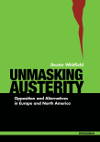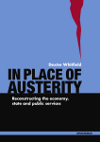KEY FINDINGS AT A GLANCE
Austerity was intended to rapidly reduce public debt by a combination of cutting public spending, reducing or freezing labour costs, tax increases and privatisation alongside reconfiguring public services and the welfare state. These measures would in turn allow the private sector to generate economic growth.
Austerity has failed because:
Government debt has continued to increase.
Reduced demand in economies has intensified the recession and the theory of ’growth friendly’ fiscal consolidation has been discredited.
Negative or weak economic growth has prevailed and the private sector has failed to fill the gap in investment created by significant reductions in public sector expenditure.
With trading partners also in recession export led growth has been stunted.
The economic and social effects of austerity:
Soaring economic costs – the loss of output, reduced wealth, unemployment and government intervention and support runs into trillions of dollars in the US alone.
5.5 million young people are unemployed in the European Union alone.
2.2m public sector job losses have followed deep cuts in public spending in the UK, US and Spain alone.
Cuts in wages, benefits and pensions have reduced take-home earnings by up to 20%.
Closures and business failures have increased in parallel with austerity.
The financial crisis led to the bankruptcy of several US towns and cities.
The house price slump resulted in large-scale foreclosures, mortgage arrears and between 10%-31% of mortgages in negative equity in the UK, US, Spain and Ireland in 2012-2013
Health services have suffered closures and patients face increased charges and longer waiting times.
Austerity has increased poverty and widened inequality and public spending cuts increased inequalities between regions.
Bailouts have protected bank bondholders, except in Iceland, in a gigantic wealth transfer from taxpayers to the corporate sector and wealthy individuals.
Meanwhile corporate profits have risen, share price highs achieved in 2013 and cash hoarding by large US corporations has mushroomed.
Public services and the welfare state are being reconfigured to embed marketisation and privatisation in parallel with austerity.
Despite public spending cuts governments are widening corporate welfare through financial aid to the private sector, deregulating markets and increasing the role of business in public policy making.
The idea that governments have no option but to adopt austerity policies is incorrect. Not only was the scale of austerity unnecessary, it was unjust and based on flawed economic theory.




